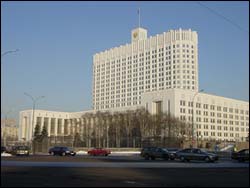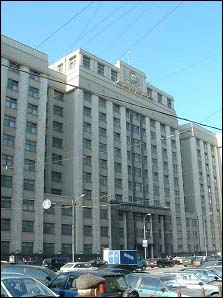 Political system and administrative divisions
Political system and administrative divisions |
According to its constitution, Russia is a democratic,
legally-based federal state with a republican form
of government (Article 1).

The White House - Prime Minister's Office
State power is vested in the President, the Federal
Assembly, the government and the courts (Article
11).
The President is the head of state and is elected
for a four-year term by universal, equal and direct
suffrage by secret ballot (Articles 80, 81).
The Federal Assembly, is the representative and
legislative body of the Russian Federation and is
composed of two Houses - the Federation Council
and the State Duma. (Articles 94, 95).

 Administrative and territorial structure
Administrative and territorial structure |
| Republics |
21 |
| Territories |
6 |
| Regions |
49 |
| Autonomous regions |
1 |
| Autonomous areas |
10 |
| Districts |
1864 |
| Cities and towns |
1098 |
| Urban districts and areas |
333 |
| Urban settlements |
1850 |
| Rural administrations |
24326 |
 The Federal Districts of the Russian Federation
The Federal Districts of the Russian Federation |
Central
Center - Moscow
North-West
Center - St. Petersburg
SouthCenter - Rostov-on-DonPrivolzhsky (Volga)Center
- Nizhny Novgorod |
Urals
Center - Ekaterinburg
Siberian
Center - Novosibirsk
Far-East
Center - Khabarovsk |
|
 The Central Federal District of The Russian
Federation
The Central Federal District of The Russian
Federation |
Moscow is this district's capital. The district
is composed of seventeen regions: Belgorod, Bryansk,
Vladimir, Voronezh, Ivanovo, Kaluga, Kostroma, Kursk,
Lipetzk, Moscow, Oryol, Ryazan, Smolensk, Tambov,
Tver, Tula and Yaroslavl.
At the end of 2001, its population was 36.5m people,
79.1 per cent of whom lived in towns and cities.
59.3% of the population is of working age. 17.5m
people had a job in 2000: 21.2% in industry, 11.0
% in agriculture and 31.7% in non-production spheres.
Total industrial output in 2001 totalled 1,063bn
roubles. Machine building and metal working accounted
for 26.2% of this industrial output, the food industry
23.9%, electrical power 11.1% and ferrous metallurgy
8.1%. Agricultural output amounted to 220.8bn roubles.
Russia is the sixth most populous country in the
world with a total resident population of 143.954.500
people (January 2002 figures) and a population density
of 8.4 inhabitants/km2.
| |
2001 |
2002 |
| Total population (million inhabitants) |
144.8 |
144.0 |
| Urban |
105.6 |
105.0 |
| Rural |
39.2 |
39.0 |
Its five largest cities are Moscow (8,305,000 people),
St Petersburg (4,628,000 people), Novosibirsk (1,393,000
people), Nizhny Novgorod (1,343,000 people) and
Yekaterinburg (1,257,000 people).
 Climate
Climate |
In January, the average temperature in the northern
Caucasus is between 0 and - 5ºC.
In the east of the Republic of Sakha, it is between
- 40 and - 50ºC and here is where you will
find the coldest inhabited place on the planet -
in January 1926, a temperature lower than -72ºC
was recorded.
|

